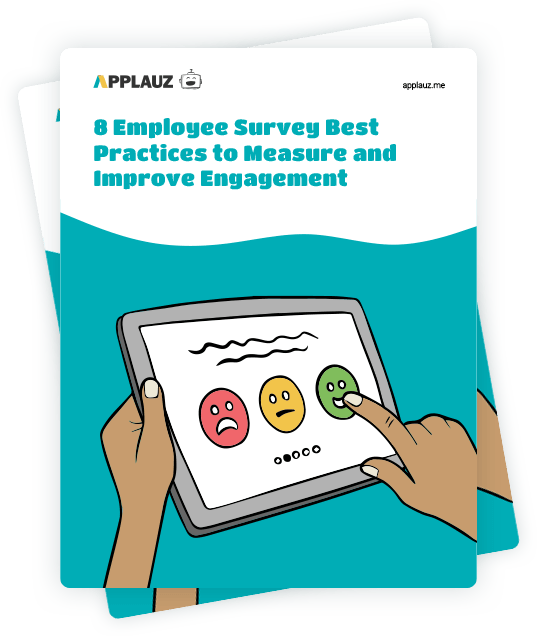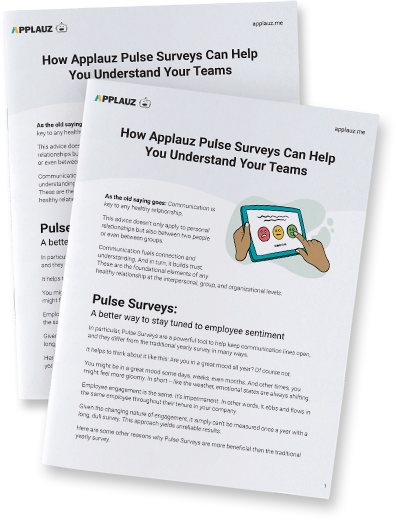I used to dread calling my bank's customer support center...
Every time I called, they would bombard me with calls the next day, asking me to complete a client satisfaction survey.
Usually, I would be happy to give the agent a positive review. But their survey consisted of about 20 questions! The survey was long; the questions were long and phrased awkwardly, too. Most importantly, I didn't see what was in it for me to answer. So I ignored the calls.

Gathering Employee Feedback With Surveys
That said, gathering employee feedback at work is something all managers are required to do at some point in their careers.
But many companies make the same mistake as my bank.
Businesses make the employee survey process time-consuming and dull. They also fail to prove the benefits to their workforce. As a result, completing surveys becomes an inconvenient task for employees.
Employees then rush through filling out surveys, skipping over entire questions — distorting the resulting data and insights.
You can avoid this with a few best practices…
In this article, we will look at some of the common mistakes companies make when surveying employees at scale. And how to design surveys that get a high response rate with clean, accurate, and actionable results.
8 Employee Survey Best Practices to Measure and Improve Engagement
Creating Employee Surveys: What to Avoid
Common error 1: Not having a clear goal
When scientists conduct research, they start with a hypothesis — they have speculated something about the issue at hand. The consequent research will confirm or deny their assumption.
 Surveying your employees without a clear goal in mind is like scientists conducting expensive research without a clear goal in mind. It's unheard of.
Surveying your employees without a clear goal in mind is like scientists conducting expensive research without a clear goal in mind. It's unheard of.
Anytime you gather employee feedback through surveys, you need to have an understanding of the goal of the survey.
Some common reasons and goals for surveying employees are:
- Assessing employee sentiment after a specific event (i.e. a holiday party, a company BBQ, etc.)
- Investigating the root cause of HR issues (i.e. high employee turnover, or absenteeism)
- Assessing new employee experience (onboarding, training, etc)
- Assessing employee happiness in regards to a specific component of work (i.e. workload, compensation, management, etc.)
- Feeling out a new policy (new benefits, work-from-home, etc)
Having a clear goal achieves two important things:
1) Determines the questions that make up the survey. You're not going to ask questions about compensation and benefits if you're surveying employees about their managers.
2) It gives employees a clear incentive to answer the survey. When employees understand why you are surveying them, they will be more likely to take the time to complete the survey.
What you should do to avoid it: Never create an employee survey without first asking yourself, "why." Make sure the reason is evident in the subject or name of the survey. For example, " Employee Survey on Compensation and Benefits," or "Employee Happiness Survey." Having a clear goal will also help you understand how to apply the results. More on that later in this article.
Common error 2: Survey goal isn’t tied to employee engagement
One of the reasons I never filled out my bank's customer satisfaction survey is because the incentive wasn’t clear.
Many companies conduct surveys in a vacuum. They send out surveys without expressing how it's tied to a larger mission to improve employee happiness.
The result: Employees view surveys as another dull admin task on their "to do" list. Low participation rates will follow.
Don't risk spending precious resources building surveys only to get low response rates.
If the survey is short and to the point, usually giving employees emotional incentive is enough to get employees to complete it.
Employee surveys should be positioned as one tool in a more significant effort to engage and build a culture of employee appreciation.
What you should do to avoid it: Explain to employees how the survey will benefit them and their teams. It's about cultivating a greater culture where  employees are given a voice and heard. Appeal to their interests. Let them know this survey's ultimate purpose is to improve the employee experience. Remind them surveys are 100% anonymous as well. The same idea applies to more casual forms of gathering feedback, such as one-on-one meetings with employees. Managers should open up the conversation stating they are open to receive both positive and negative feedback. As long as they are respectful, an employee should always feel safe expressing themselves.
employees are given a voice and heard. Appeal to their interests. Let them know this survey's ultimate purpose is to improve the employee experience. Remind them surveys are 100% anonymous as well. The same idea applies to more casual forms of gathering feedback, such as one-on-one meetings with employees. Managers should open up the conversation stating they are open to receive both positive and negative feedback. As long as they are respectful, an employee should always feel safe expressing themselves.

Common error 3: Using the wrong method of gathering feedback
You wouldn't use a 10-question survey if you simply wanted to know what your roommate or spouse wanted to eat for dinner.
Similarly, gathering feedback about the day from your team day doesn’t take a long survey either. A simple poll or brief touch base would be enough to assess daily sentiments.
That said, there are many ways to gather employee feedback from formal to highly casual methods. None of them are "wrong," each has its own advantages and disadvantages. But most importantly, each survey method is beneficial in particular contexts.
 Methodological errors fall into two categories:
Methodological errors fall into two categories:
- Companies rely solely on one method of gathering employee feedback. For example, they only collect employee feedback through lengthy, time-consuming surveys.
- Or they use a variety of survey methods but in the wrong context. For example, they use face-to-face meetings to investigate sensitive issues better suited to be answered via anonymous surveys.
Some standard methods for gathering employee feedback:
- Long-form surveys: Comprehensive surveys filled out once or twice a year
- Polls: A single question with multiple choice answers
- Face-to-face meeting: Conversation to gather subjective, qualitative information
- Suggestion Boxes: Method to anonymously gather subjective information
- Pulse Surveys: Single questions asked frequently (usually daily)
What you should do to avoid it: A good rule: Mix up your employee survey methods. In short, don't stick to one way of gathering employee feedback. For more serious investigations, use conventional survey methods that produce quantitative insights. This hard data helps identify key HR issues for your business. But it's also vital to be in tune with general employee sentiment. That means also applying time-efficient and informal methods like Polls and brief face-to-face meetings. Bottom line: Use methods that yield a mix of hard data but also anecdotal insights.
Pro Tip: Make sure to include eNPS questions in your employee survey efforts. eNPS is a question designed to measure employee loyalty and dedication accurately.
Common error 4: Build surveys based on assumptions
If you feel sick enough, most people go to the doctor to have the problem checked out. A competent physician will ask questions to test your general health and assess other factors affecting your life — stress levels, alcohol consumption, and more.
Doctors see symptoms as a product of a deeper problem. The goal is first to administer tests and ask questions to determine the root of the issue.
Likewise, surveys are a way to test organizational health when a workplace issue becomes clear. For example, employees start to quit at high rates.
Discovering the REAL underlying issue hinges on asking the right questions and administering the right test.
Companies who approach surveys the wrong way skip this step and make guesses about the root cause of organizational issues. And they build surveys on those assumptions.
For example, they assume (maybe from previous experience) that management issues cause high employee turnover. As a result, they design surveys to only assess employee satisfaction with management.
This approach  will result in only gaining a biased and partial picture of why your employees are unhappy and leaving.
will result in only gaining a biased and partial picture of why your employees are unhappy and leaving.
What about all other areas of the employee experience?
For example, benefits and compensation, career growth, leadership, work/life balance, and more.
What you should do to avoid it: When using employee surveys to investigate the root cause of high-level HR issues, like high turnover or absenteeism, surveys must include a mix of questions designed to test many areas of employee experience. Don’t make assumptions about the root cause until you have enough data to support it.
Common error 5: Faulty analysis of the results
Many formal survey tools generate reports and charts that allow managers to see results for each survey question. Some more sophisticated tools might even categorize HR issues based on survey results.
Whether you’re gathering feedback with sophisticated tools or informally through face-to-face meetings, a glaring error many companies make is to misinterpret the results.
When interpreting results, companies can fall victim to confirmation bias.

Confirmation bias is the universal tendency to give more attention to data that confirms our personal beliefs or experiences — and ignoring information that casts doubts on our beliefs.
For example, once again, executives may hold a view or opinion: poor management is the cause of high employee turnover.
As a result, when interpreting reports, they may only pay attention to the information confirming these beliefs. And downplay the information threatening it.
What you should do to avoid it: The goal is to approach gathering employee feedback with a completely open mind. You may have previous experience in this company (or a different one) which is valid. But survey results should be approached objectively, even if you see unsettling data. The ultimate goal of gathering employee feedback is to improve the employee experience. This cannot be achieved without first looking at the results honestly and impartially.
How Applauz Pulse Surveys Can Help You Understand Your Teams
Pro Tip: A Pulse Surveys tool helps HR identify areas of the workplace that need improvement. There's no need to waste time making sense of data. Survey results are distilled into clean, easy-to-read reports, eliminating all the guesswork.

Final Thoughts: Use surveys to develop engagement strategies
Making employees fill out time-consuming surveys undermines the very purpose of the survey, which is to improve employee engagement.
As a case in point, no one wants to complete a long, generic survey. Like the head-ache-inducing customer survey, my bank sends me.
Employee surveys should always be goal-oriented, short, and precise.
As a result, surveying employees should shed light on employee pain points. And also help identify the root cause of common HR issues, such as high employee turnover.
Bottom line: When done right, employee surveys should reveal key insights that assist in building an Employee Engagement Program and prioritizing your HR goals.
About the author
 Michelle Cadieux
Michelle Cadieux
Michelle is a content writer for Applauz. She holds a Bachelor's degree in Psychology from Concordia University, and she has been writing about work and employee happiness for over five years.



